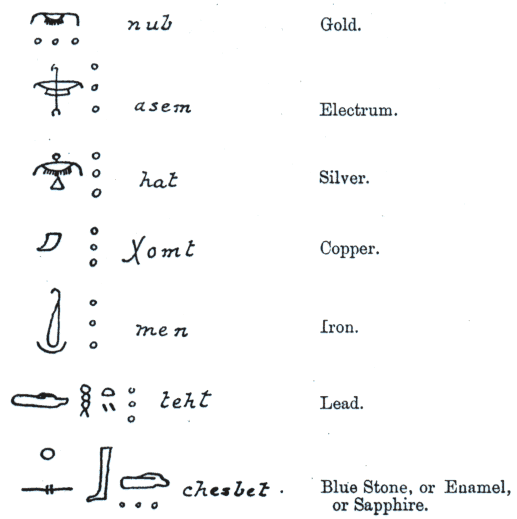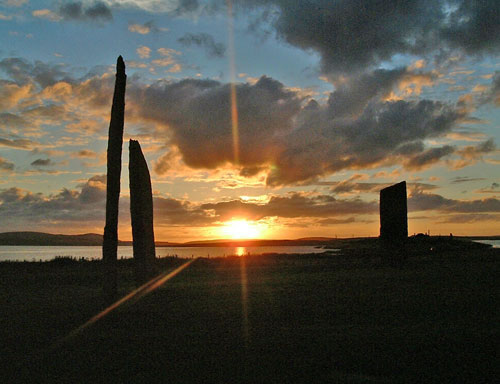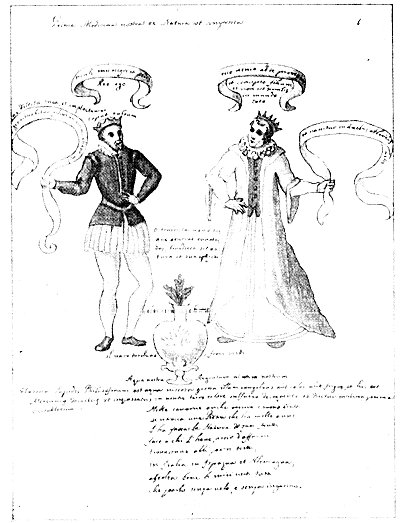In the mysterious Sephirothic Tree of the Jews, these two pillars symbolize Mercy and Severity. Standing before the gate of King Solomon’s Temple, these columns had the same symbolic import as the obelisks before the sanctuaries of Egypt. When interpreted Qabbalistically, the names of the two pillars mean “In strength shall
MOSES RECEIVING THE TABLES OF THE LAW.
From an old Bible. Moses Maimonides, the great Jewish Philosopher of the twelfth century, in describing the Tables of the Law written by the finger of God, divides all productions into two general orders: products of Nature and products of art. God works through Nature and man through art, he asserts in his Guide for the Perplexed. Thus the Word of the Lord is the hand, or active principle, by which the will of the Creator is traced upon the face of His creation. The Tannaim, or initiates of the Jewish Mystery School, alone possessed a complete understanding of the significance of the Ten Commandments. These laws are esoterically related to the ten degrees of contemplation constituting the Path of Ecstasy, which winds upward through he four worlds and ends in the effulgence of AIN SOPH.
p. 99
[paragraph continues] My House be established. “In the splendor of mental and spiritual illumination, the High Priest stood between the pillars as a mute witness to the perfect virtue of equilibrium–that hypothetical point equidistant from all extremes. He thus personified the divine nature of man in the midst of his compound constitution–the mysterious Pythagorean Monad in the presence of the Duad. On one side towered the stupendous column of the intellect; on the other, the brazen pillar of the flesh. Midway between these two stands the glorified wise man, but he cannot reach this high estate without first suffering upon the cross made by joining these pillars together. The early Jews occasionally represented the two pillars, Jachin and Boaz, as the legs of Jehovah, thereby signifying to the modern philosopher that Wisdom and Love, in their most exalted sense, support the whole order of creation–both mundane and supermundane.
THE HOLY GRAIL
Like the sapphire Schethiyâ, the Lapis Exilis, crown jewel of the Archangel Lucifer, fell from heaven. Michael, archangel of the sun and the Hidden God of Israel, at the head of the angelic hosts swooped down upon Lucifer and his legions of rebellious spirits. During the conflict, Michael with his flaming sword struck the flashing Lapis Exilis from the coronet of his adversary, and the green stone fell through all the celestial rings into the dark and immeasurable Abyss. Out of Lucifer’s radiant gem was fashioned the Sangreal, or Holy Grail, from which Christ is said to have drunk at the Last Supper.
Though some controversy exists as to whether the Grail was a cup or a platter, it is generally depicted in art as a chalice of considerable size and unusual beauty. According to the legend, Joseph of Arimathea brought the Grail Cup to the place of the crucifixion and in it caught the blood pouring from the wounds of the dying Nazarene. Later Joseph, who had become custodian of the sacred relics–the Sangreal and the Spear of Longinus–carried them into a distant country. According to one version, his descendants finally placed these relics in Glastonbury Abbey in England; according to another, in a wonderful castle on Mount Salvat, Spain, built by angels in a single night. Under the name of Preston John, Parsifal, the last of the Grail Kings, carried the Holy Cup with him into India, and it disappeared forever from the Western World. Subsequent search for the Sangreal was the motif for much of the knight errantry of the Arthurian legends and the ceremonials of the Round Table. (See the Morte d’Arthur.)
No adequate interpretation has ever been given to the Grail Mysteries. Some believe the Knights of the Holy Grail to have been a powerful organization of Christian mystics perpetuating the Ancient Wisdom under the rituals and sacraments of the oracular Cup. The quest for the Holy Grail is the eternal search for truth, and Albert G. Mackey sees in it a variation of the Masonic legend of the Lost Word so long sought by the brethren of the Craft. There is also evidence to support the claim that the story of the Grail is an elaboration of an early pagan Nature myth which has been preserved by reason of the subtle manner in which it was engrafted upon the cult of Christianity. From this particular viewpoint, the Holy Grail is undoubtedly a type of the ark or vessel in which the life of the world is preserved and therefore is significant of the body of the Great Mother–Nature. Its green color relates it to Venus and to the mystery of generation; also to the Islamic faith, whose sacred color is green and whose Sabbath is Friday, the day of Venus.

Moe is the founder of GnosticWarrior.com. He is a father, husband, author, martial arts black belt, and an expert in Gnosticism, the occult, and esotericism.




![How the South Saxons received Eadbert and Eolla, and the West Saxons, Daniel and Aldhelm, for their bishops; and of the writings of the same Aldhelm [705 A.D.] | Book 5 | Chapter 17 How the South Saxons received Eadbert and Eolla, and the West Saxons, Daniel and Aldhelm, for their bishops; and of the writings of the same Aldhelm [705 A.D.] | Book 5 | Chapter 17](https://www.gnosticwarrior.com/wp-content/plugins/contextual-related-posts/default.png)
